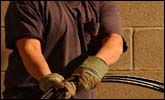| Contents |
 |
Page last reviewed: 03/24/2008 |
| Highlights |
 |
|
|

Electrical Contractors Industry
Electrical contractors are responsible for the health and safety of employees who are exposed to a variety of hazards. Some of these hazards are obvious, such as electrical shock and electrocution. Others, such as musculoskeletal disorders (MSDs), back injuries, slips and falls, or automobile-related incidents may not be as obvious. The occurrence of these injuries is increasing as the scope of work performed by the typical electrical contractor and the age of the work population increases. While much of their work is still concentrated in construction, they may also perform building maintenance or installation of data an networking applications.
This page is maintained as a product of the Alliance between OSHA and the Independent Electrical Contractors, Inc. (IEC).
Electrical hazards are addressed in specific standards for recordkeeping, the general industry, shipyard employment, marine terminals, and the construction industry.
Standards
This section highlights OSHA standards, the Regulatory Agenda (a list of actions being taken with regard to OSHA standards), directives (instructions for compliance officers), standard interpretations (official letters of interpretation of the standards), and national consensus standards related to the electrical contractors industry.
OSHA
Note: Twenty-five states, Puerto Rico and the Virgin Islands have OSHA-approved State Plans and have adopted their own standards and enforcement policies. For the most part, these States adopt standards that are identical to Federal OSHA. However, some States have adopted different standards applicable to this topic or may have different enforcement policies.
Frequently Cited Standards
The following standards, in order, were the most frequently cited by Federal OSHA from October 2010 through September 2011, in Electrical Work Industry Group (SIC Code 1731).
- 1926.405, Wiring methods, components, and equipment for general use
- 1926.403, General requirements (Electrical) [related topic page]
- 1926.453, Aerial lifts [related topic page]
- 1926.1053, Ladders
- 1926.501, Duty to have fall protection [related topic page]
- 1926.416, General requirements (Electrical)
- 1910.67, Vehicle-mounted elevating and rotating work platforms
- 1926.21, Safety training and education.
- 1926.404, Wiring design and protection
- 1926.20, General safety and health provisions
Other Highlighted Standards
Recording and reporting occupational injuries and illness (29 CFR 1904)
General Industry (29 CFR 1910)
- 1910 Subpart
I, Personal protective equipment
- 1910 Subpart J, General environmental controls
- 1910 Subpart R, Special industries
- 1910 Subpart S, Electrical
- 1910.302, Electric utilization systems
- 1910.303, General requirements [related topic page]
- 1910.304, Wiring design and protection
- 1910.305, Wiring methods, components, and equipment for general use
- 1910.306, Specific purpose equipment and installations
- 1910.307, Hazardous (classified) locations
- 1910.308, Special systems
- 1910.331, Scope
- 1910.332, Training
- 1910.333, Selection and use of work practices
- 1910.334, Use of equipment
- 1910.335, Safeguards for personnel protection
Shipyard Employment (29 CFR 1915)
Marine Terminals (29 CFR 1917)
Construction Industry (29 CFR 1926)
- 1926 Subpart
K, Electrical
- 1926.402, Applicability
- 1926.403, General requirements
- 1926.404, Wiring design and protection
- 1926.405, Wiring methods, components, and equipment for general use
- 1926.406, Specific purpose equipment and installations
- 1926.407, Hazardous (classified) locations
- 1926.408, Special systems
- 1926.416, General requirements
- 1926.417, Lockout and tagging of circuits
- 1926.431, Maintenance of equipment
- 1926.432, Environmental deterioration of equipment
- 1926.441, Batteries and battery charging
Regulatory Agenda
Directives
- Enforcement of the Electrical Power Generation, Transmission, and Distribution Standard. CPL 02-01-038 [CPL 2-1.38], (2003, June 18).
- OSHA Technical Manual (OTM). TED 01-00-015 [TED 1-0.15A], (1999, January 20).
- Electrical Safety-Related Work Practices -- Inspection Procedures and Interpretation Guidelines. STD 01-16-007 [STD 1-16.7], (1991, July 1).
- 29 CFR 1926.550(a)(15)(i) Clearance Between Electrical Power Lines and Cranes. STD 03-12-001 [STD 3-12.1A], (1980, May 9).
- Search all available directives.
Standard Interpretations
National Consensus
Note: These are NOT OSHA regulations. However, they do provide guidance from their originating organizations related to worker protection.
American National Standards Institute (ANSI)
Hazards and Solutions
In electrical work, hazards exist in many forms. Ergonomic hazards include musculoskeletal disorders (MSDs) caused by repetitive motions, contact stress from poorly designed tools, and poor lifting and handling practices. Slip and fall hazards are frequently present due to the high places and rough ground that electricians must navigate. Motor vehicles are also a source of hazards, and electrocution hazards are present in many phases of the electrical process.
Ergonomics
Ergonomic
injuries have been identified as the number one cause of worker injury, responsible for more worker's compensation claims than any other hazard, according to data provided by the Independent Electrical Contractors (IEC).
Falls
Slips, trips, and falls together account for a large portion of on-the-job accidents that electrical workers experience. These links discuss methods of eliminating such mishaps, from correct personal fall arrest systems to proper ladder usage.
Motor Vehicles
Motor vehicle accidents, and rear-end collisions in particular, make up a significant portion of all accidents experienced by electrical workers.
Electrocution
Electrocution is a significant hazard in the electrical industry. Below are links to resources with solutions for electrocution hazards.
Safety and Health Programs
An effective safety and health program depends on the credibility of management's involvement in the program, inclusion of employees in safety and health decisions, rigorous worksite analysis to identify hazards and potential hazards, including those which could result from a change in worksite conditions or practices, stringent prevention and control measures, and thorough training. It addresses hazards whether or not they are regulated by government standards. The following references characterize and further explain safety and health programs.
Additional Information
Related Safety and Health Topics Pages
Other Resources
Accessibility Assistance: Contact the OSHA Directorate of Technical Support and Emergency Management at (202) 693-2300 for assistance accessing PDF materials.
*These files are provided for downloading.
|


 Newsletter
Newsletter RSS Feeds
RSS Feeds Print This Page
Print This Page
 Text Size
Text Size

